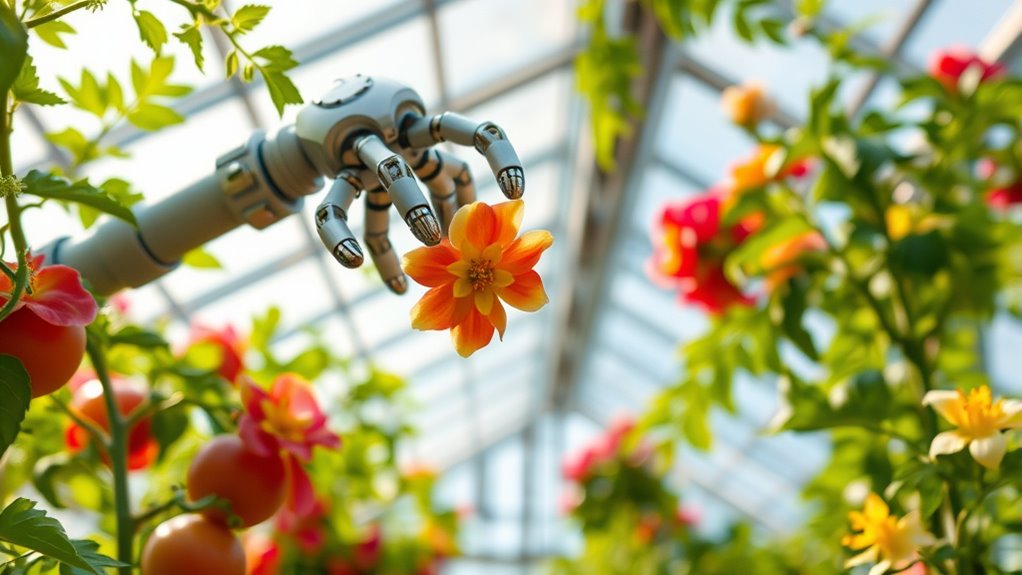Robotic pollination is transforming greenhouse reproduction by offering a reliable, efficient alternative to declining bee populations and manual methods. These smart machines use sensors, cameras, and AI to identify flowers and deliver pollen accurately, working tirelessly around the clock. They help improve crop yields, ensure consistent pollination, and collect data for better farm management. If you stay tuned, you’ll discover how this innovative technology can revolutionize your farming practices.
Key Takeaways
- Robotic pollination addresses bee population declines, ensuring consistent and reliable crop yields in greenhouses.
- It uses AI, sensors, and cameras to identify flowering plants and accurately deliver pollen.
- Operates continuously, covering large areas quickly, reducing labor costs and increasing efficiency.
- Provides real-time data for monitoring pollination progress and optimizing resource use.
- Supports sustainable agriculture by reducing reliance on natural pollinators and promoting eco-friendly practices.

As bee populations decline worldwide, scientists are turning to robotic pollination as a promising solution to guarantee crop productivity. This shift is driven by advancements in pollination technology that enable you to supplement or replace natural pollinators with machines that can perform the task efficiently and reliably. Robotic pollination systems are designed to mimic the actions of bees, targeting flowers with precision and consistency. These systems use sensors, cameras, and AI algorithms to identify flowering plants, assess their readiness for pollination, and then deliver pollen with remarkable accuracy. The goal is to optimize pollination processes, guarantee you get the best possible yield regardless of environmental conditions or declining bee populations.
Robotic pollination ensures reliable crop yields despite declining bee populations.
You’ll find that robotic efficiency is at the core of these innovations. Unlike manual labor or traditional pollination methods, robots can operate tirelessly around the clock, covering vast areas in a fraction of the time. This means you can achieve uniform pollination across your greenhouse or farm, reducing variability caused by natural factors. The consistency offered by robotic systems ensures that each flower receives the right amount of pollen, leading to higher fruit set rates and improved crop quality. Additionally, these machines can be programmed to adapt to different plant species, adjusting their movements and pollen delivery techniques accordingly. This flexibility means you don’t need multiple devices for different crops—one versatile robot can handle diverse needs, streamlining your operations.
Furthermore, pollination technology incorporated into robotic systems often includes real-time monitoring capabilities. You can track the progress of pollination tasks, identify areas that might need additional attention, and even collect data on flower health and development. This data-driven approach empowers you to make informed decisions, optimize resource use, and increase overall productivity. Robots also eliminate concerns about the variability in natural pollinator activity caused by weather, pesticide use, or disease. This predictability ensures your crops are consistently pollinated, which is crucial for large-scale greenhouse operations where uniformity is essential.
In addition, robotic pollination reduces the reliance on fragile bee populations, supporting ecological sustainability. As you adopt these advanced systems, you’re not only safeguarding your crop yields but also contributing to environmental conservation. Understanding the importance of Gold IRA and diversification strategies can help you secure your long-term financial stability while embracing innovative agricultural solutions. The integration of pollination technology with robotic efficiency offers a futuristic solution that enhances productivity, reduces labor costs, and promotes sustainable farming practices. As this technology continues to evolve, you’ll likely see even more sophisticated robots capable of working seamlessly alongside traditional methods, creating a resilient, efficient, and environmentally friendly approach to greenhouse reproduction.
Frequently Asked Questions
How Do Robotic Pollinators Impact Native Bee Populations?
Robotic pollinators can reduce native bee displacement by supplementing natural pollination efforts, but they might also threaten ecosystem balance if they replace native bees entirely. You should consider that over-reliance on robots may lead to decreased native bee populations, disrupting local ecosystems. To maintain healthy ecosystems, it’s vital to balance robotic pollination with efforts to protect and support native bee habitats and populations.
What Are the Energy Requirements for Robotic Pollination Systems?
Robotic pollination systems require a significant amount of energy consumption, primarily powered by electricity sourced from various power sources like solar, grid, or batteries. You need to take into account the efficiency of these power sources to ensure continuous operation. To minimize environmental impact, optimizing energy use and integrating renewable energy options can help reduce overall energy requirements, making robotic pollination more sustainable and cost-effective for greenhouse applications.
Can Robotic Pollinators Adapt to Different Plant Species?
Robotic pollinators can adapt to different plant species, but their effectiveness depends on their design and programming. While some systems are built with high species specificity, others incorporate advanced sensors and algorithms to recognize plant adaptability. You can expect adaptable robots to handle various plant species, but their success relies on continuous updates and learning capabilities. This flexibility is essential for diverse greenhouse environments and evolving plant varieties.
What Is the Cost Comparison Between Robotic and Natural Pollination?
You’ll find that robotic pollination generally has higher initial costs compared to natural pollination, but it offers better cost efficiency over time. Robotic systems can operate continuously and reduce labor expenses, enhancing economic viability. While the upfront investment is significant, the long-term savings and increased crop yields make robotic pollination a financially promising alternative, especially in areas facing pollinator shortages or declining natural pollinator populations.
How Reliable Are Robotic Pollination Systems in Diverse Weather Conditions?
You might think robotic pollination systems are a shot in the dark, but they’re surprisingly reliable even in diverse weather. While weather variability can challenge their functionality, modern systems are built with durable components that withstand harsh conditions. You can count on these systems to perform consistently, though occasional maintenance might be needed during extreme weather. Overall, they’re designed to be resilient, giving you peace of mind in any climate.
Conclusion
As you watch a swarm of tiny robots flit effortlessly through lush green leaves, you realize a new era has dawned. With sleek metallic bodies gently brushing against vibrant blossoms, they mimic nature’s dance, ensuring every flower is pollinated. The future of greenhouse reproduction is now, blending technology with life’s delicate beauty. You can almost hear the soft hum of progress, promising a world where pollination thrives, silent and precise, in harmony with nature’s timeless rhythm.








